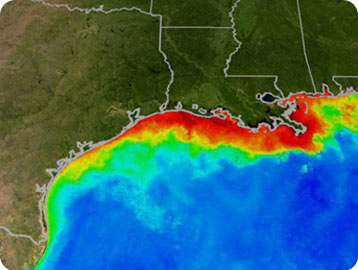Every summer, more than 6,000 square miles of the Gulf of Mexico turns into a dead zone. The Mississippi River dumps massive amounts of nutrients into the Gulf -- mainly fertilizers and animal waste from farms and ranches. That starts a chain reaction that consumes most of the oxygen at the bottom, killing off most of the shrimp and oysters that live there.
 Image showing oxygen levels in the Gulf of Mexico, blue indicates normal oxygen leves, red indicates the lowest oxygen levels. Credit: NASA/Goddard Space Flight Center Scientific Visualization Studio
Image showing oxygen levels in the Gulf of Mexico, blue indicates normal oxygen leves, red indicates the lowest oxygen levels. Credit: NASA/Goddard Space Flight Center Scientific Visualization StudioThis process isn’t good for fish, either. In fact, studies are showing that some fish stop reproducing. It may be part of a natural defense mechanism that gets out of hand.
Peter Thomas and other researchers at the University of Texas Marine Science Institute have studied reproduction in Atlantic croaker. They’ve conducted experiments in the lab, as well as field studies in the Florida Panhandle and in the dead zone off the coast of Louisiana.
Their work shows that in oxygen-poor waters, the fish’s reproductive systems basically shut down. They either produce fewer eggs, or they show abnormalities. The hormones that control reproduction are out of whack, too.
The researchers suggest that the changes are a defense mechanism. Reproduction takes a lot of energy and oxygen, and in an environment where there’s little oxygen -- like a dead zone -- it makes sense for the fish not to reproduce.
But dead zones are becoming more common all around the world -- and they’re getting bigger. That could decimate populations of croaker and many other fish -- making the dead zones even deader.
The research featured in today’s program was funded by the National Oceanic and Atmospheric Administration.

